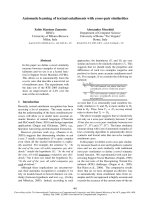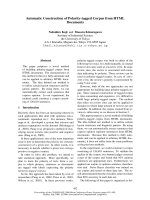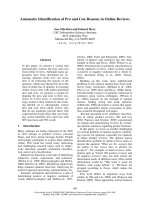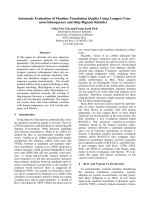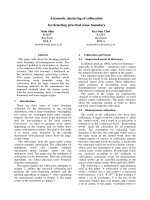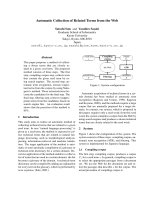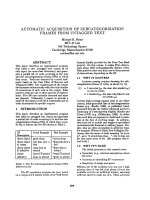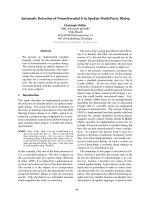Báo cáo khoa học: "Automatic Assessment of Coverage Quality in Intelligence Reports" doc
Bạn đang xem bản rút gọn của tài liệu. Xem và tải ngay bản đầy đủ của tài liệu tại đây (159.8 KB, 5 trang )
Proceedings of the 49th Annual Meeting of the Association for Computational Linguistics:shortpapers, pages 491–495,
Portland, Oregon, June 19-24, 2011.
c
2011 Association for Computational Linguistics
Automatic Assessment of Coverage Quality in Intelligence
Reports
Samuel Brody
School of Communication
and Information
Rutgers University
Paul Kantor
School of Communication
and Information
Rutgers University
Abstract
Common approaches to assessing docu-
ment quality look at shallow aspects, such
as grammar and vocabulary. For many
real-world applications, deeper notions of
quality are needed. This work represents
a first step in a project aimed at devel-
oping computational methods for deep as-
sessment of quality in the domain of intel-
ligence reports. We present an automated
system for ranking intelligence reports
with regard to coverage of relevant mate-
rial. The system employs methodologies
from the field of automatic summarization,
and achieves performance on a par with
human judges, even in the absence of the
underlying information sources.
1 Introduction
Distinguishing between high- and low-quality
documents is an important skill for humans, and
a challenging task for machines. The majority of
previous research on the subject has focused on
low-level measures of quality, such as spelling,
vocabulary and grammar. However, in many
real-world situations, it is necessary to employ
deeper criteria, which look at the content of the
document and the structure of argumentation.
One example where such criteria are essential
is decision-making in the intelligence commu-
nity. This is also a domain where computational
methods can play an important role. In a typi-
cal situation, an intelligence officer faced with an
important decision receives reports from a team
of analysts on a specific topic of interest. Each
decision may involve several areas of interest,
resulting in several collections of reports. Addi-
tionally, the officer may be engaged in many de-
cision processes within a small window of time.
Given the nature of the task, it is vital that
the limited time be used effectively, i.e., that
the highest-quality information be handled first.
Our project aims to provide a system that will
assist intelligence officers in the decision making
process by quickly and accurately ranking re-
ports according to the most important criteria
for the task.
In this paper, as a first step in the project,
we focus on content-related criteria. In particu-
lar, we chose to start with the aspect of “cover-
age”. Coverage is perhaps the most important
element in a time-sensitive scenario, where an
intelligence officer may need to choose among
several reports while ensuring no relevant and
important topics are overlooked.
2 Related Work
Much of the work on automatic assessment of
document quality has focused on student essays
(e.g., Larkey 1998; Shermis and Burstein 2002;
Burstein et al. 2004), for the purpose of grad-
ing or assisting the writers (e.g., ESL students).
This research looks primarily at issues of gram-
mar, lexical selection, etc. For the purpose of
judging the quality of intelligence reports, these
aspects are relatively peripheral, and relevant
mostly through their effect on the overall read-
ability of the document. The criteria judged
most important for determining the quality of
an intelligence report (see Sec. 2.1) are more
complex and deal with a deeper level of repre-
sentation.
In this work, we chose to start with crite-
ria related to content choice. For this task,
491
we propose that the most closely related prior
research is that on automatic summarization,
specifically multi-document extractive summa-
rization. Extractive summarization works along
the following lines (Goldstein et al., 2000): (1)
analyze the input document(s) for important
themes; (2) select the best sentences to include
in the summary, taking into account the sum-
marization aspects (coverage, relevance, redun-
dancy) and generation aspects (grammaticality,
sentence flow, etc.). Since we are interested in
content choice, we focus on the summarization
aspects, starting with coverage. Effective ways
of representing content and ensuring coverage
are the subject of ongoing research in the field
(e.g., Gillick et al. 2009, Haghighi and Vander-
wende 2009). In our work, we draw on ele-
ments from this research. However, they must
be adapted to our task of quality assessment and
must take into account the specific characteris-
tics of our domain of intelligence reports. More
detail is provided in Sec. 3.1.
2.1 The ARDA Challenge Workshop
Given the nature of our domain, real-world data
and gold standard evaluations are difficult to ob-
tain. We were fortunate to gain access to the
reports and evaluations from the ARDA work-
shop (Morse et al., 2004), which was conducted
by NIST in 2004. The workshop was designed to
demonstrate the feasibility of assessing the effec-
tiveness of information retrieval systems. Dur-
ing the workshop, seven intelligence analysts
were each asked to use one of several IR sys-
tems to obtain information about eight different
scenarios and write a report about each. This
resulted in 56 individual reports.
The same seven analysts were then asked to
judge each of the 56 reports (including their
own) on several criteria on a scale of 0 (worst)
to 5 (best). These criteria, listed in Table 1,
were chosen by the researchers as desirable in
a “high-quality” intelligence report. From an
NLP perspective they can be divided into three
broad categories: content selection, structure,
and readability. The written reports, along with
their associated human quality judgments, form
the dataset used in our experiments. As men-
tioned, this work focuses on coverage. When as-
Content
COVER covers the material relevant to the query
NO-IRR avoids irrelevant material
NO-RED avoids redundancy
Structure
ORG organized presentation of material
Readability
CLEAR clear and easy to read and understand
Table 1: Quality criteria used in the ARDA work-
shop, divided into broad categories.
sessing coverage, it is only meaningful to com-
pare reports on the same scenario. Therefore,
we regard our dataset as 8 collections (Scenario
A to Scenario H), each containing 7 reports.
3 Experiments
3.1 Methodology
In the ARDA workshop, the analysts were
tasked to extract and present the information
which was relevant to the query subject. This
can be viewed as a summarization task. In fact,
a high quality report shares many of the charac-
teristics of a good document summary. In par-
ticular, it seeks to cover as much of the impor-
tant information as possible, while avoiding re-
dundancy and irrelevant information.
When seeking to assess these qualities, we
can treat the analysts’ reports as output from
(human) summarization systems, and employ
methods from automatic summarization to eval-
uate how well they did.
One challenge to our analysis is that we do
not have access to the information sources used
by the analysts. This limitation is inherent to
the domain, and will necessarily impact the as-
sessment of coverage, since we have no means of
determining whether an analyst has included all
the relevant information to which she, in partic-
ular, had access. We can only assess coverage
with respect to what was included in the other
analysts’ reports. For our task, however, this
is sufficient, since our purpose is to identify, for
the person who must choose among them, the
report which is most comprehensive in its cover-
age, or indicate a subset of reports which cover
all topics discussed in the collection as a whole
1
.
1
The absence of the sources also means the system
is only able to compare reports on the same subject, as
opposed to humans, who might rank the coverage quality
492
As a first step in modeling relevant concepts
we employ a word-gram representation, and use
frequency as a measure of relevance. Exam-
ination of high-quality human summaries has
shown that frequency is an important factor
(Nenkova et al., 2006), and word-gram repre-
sentations are employed in many summariza-
tion systems (e.g., Radev et al. 2004, Gillick and
Favre 2009). Following Gillick and Favre (2009),
we use a bigram representation of concepts
2
. For
each document collection D, we calculate the av-
erage prevalence of every bigram concept in the
collection:
prev
D
(c) =
1
|D|
r∈D
Count
r
(c) (1)
Where r labels a report in the collection, and
Count
r
(c) is the number of times the concept c
appears in report r.
This scoring function gives higher weight to
concepts which many reports mentioned many
times. These are, presumably, the terms consid-
ered important to the subject of interest. We
ignore concepts (bigrams) composed entirely of
stop words. To model the coverage of a report,
we calculate a weighted sum of the concepts it
mentions (multiple mentions do not increase this
score), using the prevalence score as the weight,
as shown in Equation 2.
CoverScore(r ∈ D) =
c∈Concepts(r)
prev
D
(c)
(2)
Here, Concepts(r) is the set of concepts ap-
pearing at least once in report r. The system
produces a ranking of the reports in order of
their coverage score (where highest is considered
best).
3.2 Evaluation
As a gold standard, we use the average of
the scores given to each report by the human
of two reports on completely different subjects, based on
external knowledge. For our usage scenario, this is not
an issue.
2
We also experimented with unigram and trigram rep-
resentations, which did not do as well as the bigram rep-
resentation (as suggested by Gillick and Favre 2009).
judges
3
. Since we are interested in ranking re-
ports by coverage, we convert the scores from
the original numerical scale to a ranked list.
We evaluate the performance of the algorithms
(and of the individual judges) using Kendall’s
Tau to measure concordance with the gold stan-
dard. Kendall’s Tau coefficient (τ
k
) is com-
monly used (e.g., Jijkoun and Hofmann 2009)
to compare rankings, and looks at the number
of pairs of ranked items that agree or disagree
with the ordering in the gold standard. Let
T = {(a
i
, a
j
) : a
i
≺
g
a
j
} denote the set of pairs
ordered in the gold standard (a
i
precedes a
j
).
Let R = {(a
l
, a
m
) : a
l
≺
r
a
m
} denote the set of
pairs ordered by a ranking algorithm. C = T ∩R
is the set of concordant pairs, i.e., pairs ordered
the same way in the gold standard and in the
ranking, and D = T ∩ R is the set of discordant
pairs. Kendall’s rank correlation coefficient τ
k
is
defined as follows:
τ
k
=
|C| − |D|
|T |
(3)
The value of τ
k
ranges from -1 (reversed rank-
ing) to 1 (perfect agreement), with 0 being
equivalent to a random ranking (50% agree-
ment). As a simple baseline system, we rank the
reports according to their length in words, which
asserts that a longer document has “more cov-
erage”. For comparison, we also examine agree-
ment between individual human judges and the
gold standard. In each scenario, we calculate
the average agreement (Tau value) between an
individual judge and the gold standard, and also
look at the highest and lowest Tau value from
among the individual judges.
3.3 Results
Figure 1 presents the results of our ranking ex-
periments on each of the eight scenarios.
Human Performance There is a relatively
wide range of performance among the human
3
Since the judges in the NIST experiment were also
the writers of the documents, and the workshop report
(Morse et al., 2004) identified a bias of the individual
judges when evaluating their own reports, we did not
include the score given by the report’s author in this
average. I.e, the gold standard score was the average of
the scores given by the 6 judges who were not the author.
493
-0.2
0
0.2
0.4
0.6
0.8
1
HGFEDCBA
Agreement
Scenario
Num. Words
Judges
Concepts
Figure 1: Agreement scores (Kendall’s Tau) for the word-count baseline (Num. Words), the concept-based
algorithm (Concepts). Scores for the individual human judges (Judges) are given as a range from lowest to
highest individual agreement score, with ‘x’ indicating the average.
judges. This is indicative of the cognitive com-
plexity of the notion of coverage. We can see
that some human judges are better than oth-
ers at assessing this quality (as represented by
the gold standard). It is interesting to note that
there was not a single individual judge who was
worst or best across all cases. A system that out-
performs some individual human judge on this
task can be considered successful, and one that
surpasses the average individual agreement even
more so.
Baseline The experiments bear out the intu-
ition that led to our choice of baseline. The num-
ber of words in a document is significantly corre-
lated with its gold-standard coverage rank. This
simple baseline is surprisingly effective, outper-
forming the worst human judge in seven out of
eight scenarios, and doing better than the aver-
age individual in two of them.
System Performance Our concept-based
ranking system exhibits very strong perfor-
mance
4
. It is as good or better than the
baseline in all scenarios. It outperforms the
worst individual human judge in seven of the
eight cases, and does better than the average
individual agreement in four. This is in spite of
the fact that the system had no access to the
4
Our conclusions are based on the observed differences
in performance, although statistical significance is diffi-
cult to assess, due to the small sample size.
sources of information available to the writers
(and judges) of the reports.
When calculating the overall agreement with
the gold-standard over all the scenarios, our
concept-based system came in second, outper-
forming all but one of the human judges. The
word-count baseline was in the last place, close
behind a human judge. A unigram-based sys-
tem (which was our first attempt at modeling
concepts) tied for third place with two human
judges.
3.4 Discussion and Future Work
We have presented a system for assessing the
relative quality of intelligence reports with re-
gard to their coverage. Our method makes use
of ideas from the summarization literature de-
signed to capture the notion of content units and
relevance. Our system is as accurate as individ-
ual human judges for this concept.
The bigram representation we employ is only
a rough approximation of actual concepts or
themes. We are in the process of obtaining more
documents in the domain, which will allow the
use of more complex models and more sophis-
ticated representations. In particular, we are
considering clusters of terms and probabilistic
topic models such as LDA (Blei et al., 2003).
However, the limitations of our domain, primar-
494
ily the small amount of relatively short docu-
ments, may restrict their applicability, and ad-
vocate instead the use of semantic knowledge
and resources.
This work represents a first step in the com-
plex task of assessing the quality of intelligence
reports. In this paper we focused on coverage -
perhaps the most important aspect in determin-
ing which single report to read among several.
There are many other important factors in as-
sessing quality, as described in Section 2.1. We
will address these in future stages of the quality
assessment project.
4 ACKNOWLEDGMENTS
The authors were funded by an IC Postdoc
Grant (HM 1582-09-01-0022). The second
author also acknowledges the support of the
AQUAINT program, and the KDD program un-
der NSF Grants SES 05-18543 and CCR 00-
87022. We would like to thank Dr. Emile
Morse of NIST for her generosity in providing
the documents and set of judgments from the
ARDA Challenge Workshop project, and Prof.
Dragomir Radev for his assistance and advice.
We would also like to thank the anonymous re-
viewers for their helpful comments.
References
Blei, David M., Andrew Y. Ng, and Michael I.
Jordan. 2003. Latent dirichlet allocation.
Journal of Machine Learning Research 3:993–
1022.
Burstein, Jill, Martin Chodorow, and Claudia
Leacock. 2004. Automated essay evaluation:
the criterion online writing service. AI Mag.
25:27–36.
Gillick, Dan and Benoit Favre. 2009. A scal-
able global model for summarization. In Proc.
of the Workshop on Integer Linear Program-
ming for Natural Language Processing. ACL,
Stroudsburg, PA, USA, ILP ’09, pages 10–18.
Gillick, Daniel, Benoit Favre, Dilek Hakkani-
Tur, Berndt Bohnet, Yang Liu, and Shasha
Xie. 2009. The ICSI/UTD Summarization
System at TAC 2009. In Proc. of the Text
Analysis Conference workshop, Gaithersburg,
MD (USA).
Goldstein, Jade, Vibhu Mittal, Jaime Carbonell,
and Mark Kantrowitz. 2000. Multi-document
summarization by sentence extraction. In
Proc. of the 2000 NAACL-ANLP Work-
shop on Automatic summarization - Volume
4 . Association for Computational Linguis-
tics, Stroudsburg, PA, USA, NAACL-ANLP-
AutoSum ’00, pages 40–48.
Haghighi, Aria and Lucy Vanderwende. 2009.
Exploring content models for multi-document
summarization. In Proc. of Human Language
Technologies: The 2009 Annual Conference
of the North American Chapter of the Asso-
ciation for Computational Linguistics. ACL,
Boulder, Colorado, pages 362–370.
Jijkoun, Valentin and Katja Hofmann. 2009.
Generating a non-english subjectivity lexicon:
Relations that matter. In Proc. of the 12th
Conference of the European Chapter of the
ACL (EACL 2009). ACL, Athens, Greece,
pages 398–405.
Larkey, Leah S. 1998. Automatic essay grad-
ing using text categorization techniques. In
SIGIR ’98: Proceedings of the 21st annual
international ACM SIGIR conference on Re-
search and development in information re-
trieval. ACM, New York, NY, USA, pages 90–
95.
Morse, Emile L., Jean Scholtz, Paul Kantor, Di-
ane Kelly, and Ying Sun. 2004. An investi-
gation of evaluation metrics for analytic ques-
tion answering. Available by request from the
first author.
Nenkova, Ani, Lucy Vanderwende, and Kath-
leen McKeown. 2006. A compositional context
sensitive multi-document summarizer: ex-
ploring the factors that influence summariza-
tion. In SIGIR. ACM, pages 573–580.
Radev, Dragomir R., Hongyan Jing, Malgorzata
Sty´s, and Daniel Tam. 2004. Centroid-based
summarization of multiple documents. Inf.
Process. Manage. 40:919–938.
Shermis, Mark D. and Jill C. Burstein, editors.
2002. Automated Essay Scoring: A Cross-
disciplinary Perspective. Routledge, 1 edition.
495

